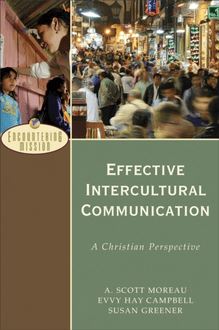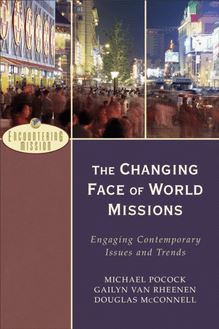Encountering the History of Missions (Encountering Mission) , livre ebook
305
pages
English
Ebooks
2017
Vous pourrez modifier la taille du texte de cet ouvrage
Obtenez un accès à la bibliothèque pour le consulter en ligne En savoir plus
Découvre YouScribe en t'inscrivant gratuitement
Découvre YouScribe en t'inscrivant gratuitement
305
pages
English
Ebooks
2017
Vous pourrez modifier la taille du texte de cet ouvrage
Obtenez un accès à la bibliothèque pour le consulter en ligne En savoir plus
Publié par
Date de parution
22 août 2017
Nombre de lectures
0
EAN13
9781493406227
Langue
English
Poids de l'ouvrage
5 Mo
Publié par
Date de parution
22 août 2017
Nombre de lectures
0
EAN13
9781493406227
Langue
English
Poids de l'ouvrage
5 Mo
Cover
Series Page
A. Scott Moreau, series editor
A LSO IN THE S ERIES :
Introducing World Missions: A Biblical, Historical, and Practical Survey
A. Scott Moreau, Gary R. Corwin, and Gary B. McGee
The Changing Face of World Missions: Engaging Contemporary Issues and Trends
Michael Pocock, Gailyn Van Rheenen, and Douglas McConnell
Encountering Missionary Life and Work: Preparing for Intercultural Ministry
Tom Steffen and Lois McKinney Douglas
Christianity Encountering World Religions: The Practice of Mission in the Twenty-first Century
Terry Muck and Frances S. Adeney
Encountering Theology of Mission: Biblical Foundations, Historical Developments, and Contemporary Issues
Craig Ott and Stephen J. Strauss with Timothy C. Tennent
Developing a Strategy for Missions: A Biblical, Historical, and Cultural Introduction
John Mark Terry and J. D. Payne
Effective Intercultural Communication: A Christian Perspective
A. Scott Moreau, Evvy Hay Campbell, and Susan Greener
Title Page
Copyright Page
© 2017 by John Mark Terry and Robert L. Gallagher
Published by Baker Academic
a division of Baker Publishing Group
P.O. Box 6287, Grand Rapids, MI 49516-6287
www.bakeracademic.com
Ebook edition created 2017
Ebook corrections 08.09.2017
All rights reserved. No part of this publication may be reproduced, stored in a retrieval system, or transmitted in any form or by any means—for example, electronic, photocopy, recording—without the prior written permission of the publisher. The only exception is brief quotations in printed reviews.
Library of Congress Cataloging-in-Publication Data is on file at the Library of Congress, Washington, DC.
ISBN 978-1-4934-0622-7
Scripture quotations are from the Holy Bible, New International Version®. NIV®. Copyright © 1973, 1978, 1984, 2011 by Biblica, Inc.™ Used by permission of Zondervan. All rights reserved worldwide. www.zondervan.com
“[A shepherd boy fell sad one day]” from THE MEMORY PALACE OF MATTEO RICCI by Jonathan Spence, copyright © 1983, 1984 by the Jonathan D. Spence Children’s Trust. Used by permission of Viking Books, an imprint of Penguin Publishing Group, a division of Penguin Random House LLC. All rights reserved.
Contents
Cover i
Series Page ii
Title Page iii
Copyright Page iv
Preface vi
1. Missions in the Early Church 1
2. Encountering Church of the East Missions 23
3. Encountering Celtic Missions 42
4. Encountering Orthodox Missions 63
5. Encountering Dominican and Franciscan Missions 89
6. Encountering Medieval Renewal Missions 110
7. Encountering Reformation Missions 130
8. Encountering Jesuit Missions 150
9. Encountering Pietist Missions 173
10. Encountering Moravian Missions 199
11. Encountering Methodist Missions 224
12. The Great Century of Protestant Missions, Part I 243
13. The Great Century, Part II 258
14. The Twentieth Century 276
15. Missionary Councils and Congresses 300
16. Specialized Missions 314
17. The Church Growth Movement 334
18. In Retrospect and Prospect 355
Reference List 363
Index 389
Back Cover 407
Preface
My mother taught me (John Mark) to love history. She read me history books before I learned to read. Thus, researching and writing this book brought joy to me. I find the history of missions to be both instructive and inspiring. The history of missions instructs contemporary missionaries on what to do and what not to do. For example, the story of Adoniram Judson, pioneer missionary to Burma, instructs us on the importance of Bible translation. That same story should inspire modern missionaries to persevere amid hardship and tragedy. Yet, the problems that resulted from financial subsidy should inform decisions today.
Writing a book on the history of missions presents the writer with a great dilemma: what to include and what to omit. Kenneth Scott Latourette is recognized as the greatest missions historian. His massive History of the Expansion of Christianity is seven volumes, and it was published in 1938. A lot of history has happened since 1938. Robert Gallagher and I had to cover the entire history of missions in just one volume. Inevitably, students, professors, and reviewers will wonder why we did not include this or exclude that. I feel as the apostle John must have felt. At the end of his Gospel he wrote, “Jesus did many other things as well. If every one of them were written down, I suppose that even the whole world would not have room for the books that would be written” (John 21:25). There just was not space to include everything.
I am grateful to Scott Moreau, our editor, for his patience and helpful suggestions. I also thank Broadman & Holman Publishers for permission to use the material in chapter 1. That material appears in substantially the same form in Missiology: An Introduction. My career as a missionary has ended, and my years of teaching missions will end soon. I thank the Lord that he called me to serve as a missionary and allowed me to train many missionaries. Like the apostle Paul, I have sought to be faithful to my “heavenly vision” (Acts 26:19).
John Mark Terry
I (Robert) am thankful for the encouragement and affirmation of a number of people who have supported this project to its fruition. Particularly, I would like to thank: Paul E. Pierson, dean emeritus and senior professor of history of mission and Latin American studies at Fuller Theological Seminary, who first ignited my interest in the history of missions as I listened to his lectures in Travis Auditorium nearly thirty years ago. The late Gary B. McGee, distinguished professor emeritus of church history and Pentecostal studies at the Assemblies of God Theological Seminary, whose gentle guidance brought confirmation via my church history presentations at the American Society of Missiology, the Association of Professors of Missions, the Evangelical Missiological Society, and the Society for Pentecostal Studies. A. Scott Moreau, associate academic dean and professor of intercultural studies at Wheaton College Graduate School, who has been my colleague, coach, sponsor, editor, and friend for twenty years. The leadership at Wheaton College, who have generously provided resources for my research and professional development. Students in missions history and intercultural studies over the last ten years who gave valuable feedback on my manuscript, such as Will Abercrombie, Erika Anderson, Amanda Barnett, Kate and Phil Bookhamer, Taylor Burnham, Kathryn Crimm, Hannah Dagenhart, Sarah Kelly, Hannah Markley, Caprice Miller, Melody Scott, Harry Smith, Krissy Stuart, Luke Tseng, Joy Viguier, Sara Vroom, and Sarah Willing. Jim Kinney, Eric Salo, and the editorial team at Baker Academic, for the meticulous process of ensuring a high standard of quality for the textbook.
Most importantly, I am grateful for the love and support of my family: Luisa and Sarita Gallagher, who, as professors in the College of Christian Studies at George Fox University (Newberg, Oregon) were my conversation partners on this manuscript, giving me space and time to think out loud about the history of missions. Caprice, Landon, Sydney, Bobbie, Norlyn, and Otha, who provided inspiration and reinforcement. My wife, Jayna, was there when I initiated the book and walked with me through the years of writing. I admire the gracious wisdom and loving maturity she embodies as she joyfully lives her life while tirelessly providing moral and emotional support.
Robert L. Gallagher
Encountering the History of Missions Series
Encountering the History of Missions is the most recent addition to the award-winning Encountering Mission series. Each book focuses on mission from an evangelical perspective. For many years, J. Herbert Kane’s textbooks, including The Making of a Missionary (1975), Understanding Christian Missions (1976), Christian Missions in Biblical Perspective (1976), A Concise History of the Christian World Mission (1978), Life and Work on the Mission Field (1980), and The Christian World Mission: Today and Tomorrow (1981), have been widely used in seminaries and Bible colleges as introductory texts. With the passing of time, however, his classic works have become dated, and Baker Publishing Group recognized that the time had come to develop a series of books to replace Kane’s gifts to the mission community. The Encountering Mission series, then, builds on the best of Kane’s work but also extends the discussion in significant ways to meet the needs of those who are preparing for effective missional engagement in today’s world.
1 Missions in the Early Church
In AD 325 Emperor Constantine and Bishop Hosius welcomed 318 bishops to the Council of Nicaea. These bishops represented churches from Spain all the way to Persia. How did the church grow from the small group that met in the “upper room” in Jerusalem to the massive institution reflected at Nicaea? Answering this question is a worthwhile effort. As Martin Hengel said, “The history and the theology of early Christianity are mission-history and mission-theology” (Weinrich 1981, 61). He means that one cannot understand the history of the early church without considering the missionary activity of the church. Further, one can understand the development of the church today only by studying its past expansion. The successes and failures of Christianity’s past should inform its future.
Therefore, in this chapter we will examine the ways in which the church expanded from AD 100 to AD 500. Historians usually discuss this period in two parts, divided by the Council of Nicaea in AD 325. The period before Nicaea is called the ante-Nicene, and the period after it is called the post-Nicene. The chapter will focus on the methods employed by the early church, not on geography. Hopefully, when you finish this chapter, you will understand how the church grew during this crucial period in its history.
Missions in the Ante-Nicene Church
The Church at the End of the Apostolic Age
The end of the apostolic age coinci








